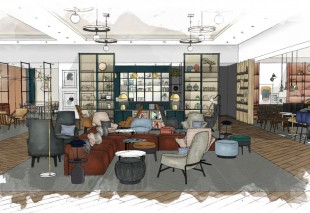

Marriott reveals $500m revamp plans for Sheraton

Marriott International has revealed a "transformation vision" for its third largest brand, Sheraton Hotels and Resorts. The company said the brand will undergo changes in its public spaces to reflect the focus on guest experience, hotel operations and design philosophy.
Commenting on the brand revamp, Marriott International president and CEO Arne Sorenson said the revitalisation of Sheraton has been a priority since the Starwood merger in 2016.
“We knew that the way to restore this incredible brand was focus and collaboration with our hotel owners. We wanted to build on Sheraton’s rich legacy of sitting at the heart of communities across the globe, but also to create a differentiated positioning and compelling proposition for our owners. With our Sheraton transformation plan, we’ve put together all of the pieces of the equation to work cooperatively with our owners to set this iconic brand on a new, disciplined and successful path. We are ready, our vision is clear and the energy is robust for Sheraton,” Sorenson said.
The company estimated that nearly US $500 million has already been invested by the owner in the US. Globally, 25% of the Sheraton property owners have also committed towards the renovations with some project already underway.
Marriott International senior vice president & global brand leader, classic full service brands Julius Robinson told Hotelier Middle East that the commitment also includes select properties in the Middle East and North Africa region. However, he said that guests can expect different iterations of the revamp based on the cultural influences of the local region.
Robinson added that through the renovations, Sheraton “wants to pull the notion of community together through changes in productivity, food and beverage, and meetings”.
“We are taking a fresh look at our lobby. We have done research and analysis to model our lobbies basically after modern-day town squares. There are so many great things that happen in a town square, there’s so much diversity, and we thought that if we could bring the essence of that into a hotel environment, we could create a space where guests would want to be, gather and meet.”
The “town square” model, Robinson says, would translate to design elements that would provide guests collaborative venues with technology enabled designs, specific places to work, an all-day food and beverage philosophy and quiet zones for guests such as privacy booths for personal time and phone calls.
Robinson noted that the renovations are expected to take place over the next three to five years before there is significant change across the entire Sheraton brand.
Currently, Marriott is showcasing the future vision of Sheraton’s public spaces with a 4,200-square-foot build-out at the NYU International Hospitality Industry Investment Conference in New York for a first glace for the owner and investment community. But Robinson says part of the experience will also be showcased in Milan next week and also identify select hotels across the globe that Marriott will use as early adopters for owners and investors to see the company’s vision moving forward.
Sheraton’s portfolio currently consists of nearly 450 open hotels with 80 additional projects in the pipeline in 72 countries and territories. By 2020, the brand’s footprint is expected to expand to 90 countries.